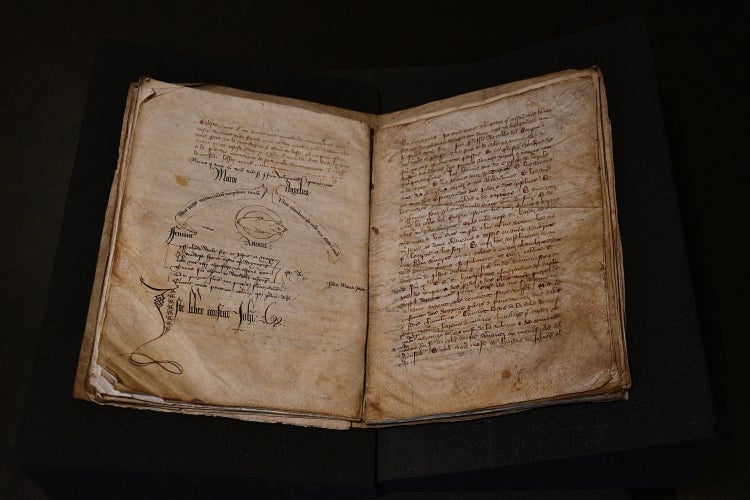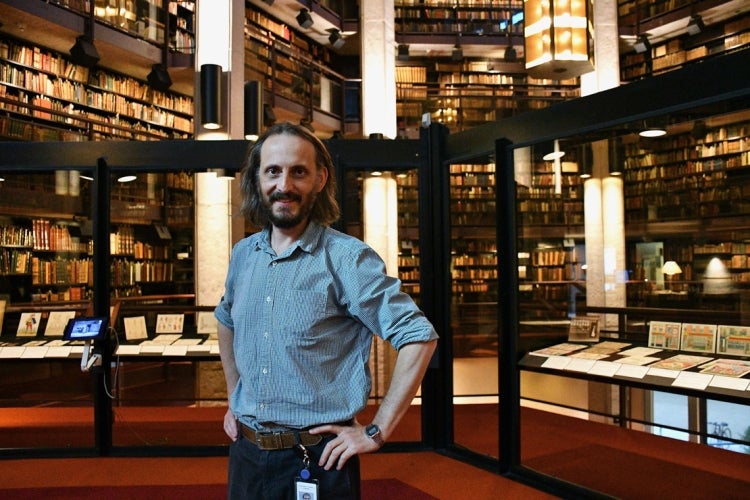'A medieval blockbuster': U of T acquires a rare 14th-century manuscript

Sebastian Sobecki stands over The Travels of Sir John Mandeville, which scholars believe was written in the mid-1300s (all photos by Diana Tyszko)
Published: September 18, 2023
The University of Toronto has acquired an ancient manuscript widely regarded as one of “medieval Europe’s biggest bestsellers.”
Led by the efforts of Sebastian Sobecki, a partial copy of The Travels of Sir John Mandeville that scholars believed was penned in the mid-1300s is now part of the Thomas Fisher Rare Book Library’s collection.
“This is one of the texts that made explorers believe in circumnavigation,” says Sobecki, a professor in the Faculty of Arts & Science’s department of English who cross-appointed to the Centre for Medieval Studies.
To secure the ancient manuscript, Sobecki collaborated with the Fisher Library as well as the University Library.
“This is big news for the university – I'm thrilled,” says Sobecki. “This is probably one of our most important medieval manuscripts and it could be a crown jewel of the Fisher collection.”

“It’s quite likely that this is the earliest surviving copy of what was one of the most popular and influential works of the Middle Ages,” says Tim Perry, a medieval manuscripts and early books librarian at the Fisher Library.
The manuscript was purchased from Bernard Quaritch Ltd – a London-based bookseller that specializes in rare books and manuscripts. Previously, it was owned by the Duke of Manchester’s family in the United Kingdom.
Written in insular French (or Anglo-French), the manuscript consists of 40 leaves – or 80 pages – and includes a substantial fragment of Mandeville’s Travels (chapters 11-12, 13-16 and 23-31). Each leaf measures approximately 27.5 by 18.5 centimetres.
The writing is on specially prepared animal skin – likely sheep or calf skin – rather than paper.
The book purports to be the travel memoir of Mandeville, though it’s more accurately described as fiction. He claims to have travelled through Turkey, Persia, Syria, Arabia, Egypt, Libya, Ethiopia, India and China in the 1320s or '30s.
It’s filled with tales of exotic beasts, treasures beyond imagination, as well as magical kingdoms with mythical people such as dog-headed humans and other strange creatures – all hallmarks of today's science fiction – and the book is considered by some to be one of the first widespread tales in the genre.
And the Travels goes beyond simply writing about destinations, delving into subjects such as religion and politics. For example, while trekking through Egypt, Mandeville engages in a lengthy conversation with the sultan of Egypt.
“They exchange ideas about the Qur’an and the Bible,” says Sobecki. “And they discuss differences of belief between Muslims and Christians. It's really quite open-minded.
“But it's not a religious text. This is a secular adventure text about [fictional] monsters of the East and what Asia looks like. This is one of the great global travel writing texts and it's remarkable for its tolerance and openness.”
Part of that adventure includes visiting the enchanted kingdom of Prester John, a legendary Christian patriarch and king who ruled over a large Christian settlement in India.
Mandeville describes the kingdom as having unmatched wealth with an abundance of precious stones, including an entire river composed of gemstones instead of water, which flows down from enormous mountains, and yields especially sweet-tasting fish.

Where did the author get his material for this book? From combining several authentic travel accounts from a variety of sources and adding his own flair.
“There's quite a lot of material from the 13th-century Franciscan missions to the Mongols,” says Sobecki. “They brought back fantastic reports about the peoples of Central Asia. Some of them are accurate, some are laced with fiction and science fiction.”
So who, exactly, was Sir John Mandeville?
“That’s a good question. We don't know that,” says Sobecki, noting that it is the subject of scholarly debate. “John Mandeville was probably a fictional name, one of the earliest pen names.”
Whoever the author is, it’s generally accepted that he didn’t do much travelling himself. However, he was a master at taking other people’s accounts and creating a new narrative.
“Someone said, very accurately, that his longest journey was to the nearest library,” says Sobecki. “So he was probably the world's greatest armchair traveller.”
Some scholars have suggested that the Travels was written by Jan de Langhe, a Flemish monk pretending to be an Englishman. He was known to be a prolific writer and avid collector of travel memoirs right up to his death in 1383.
What also makes this manuscript so important is that it’s far more than just a prize – it’s a valuable tool for research and teaching.
“This is a book for readers, for real use,” says Sobecki. “We're trying to work out where in the family tree of Mandeville manuscripts this text belongs. And for teaching purposes this text would be enormously helpful because Mandeville is a canonical English writer and is taught every year, not only in my course, but in several others across U of T. This manuscript also presents many teaching opportunities for undergraduate, master’s and PhD students: comparing later Middle English translations to the original Anglo-French text.”
As well, this text can shed light on many other facets of historical literature and publishing.
“Once we know where this manuscript fits, maybe we can locate the particular dialect where the writing came from,” says Sobecki. “We can also understand more about how these early medieval manuscripts of Mandeville’s Travels were circulated in England.”
Sobecki adds that he can’t wait to dive into Mandeville’s pages and see what secrets can be unlocked.
“This text has really inspired people,” he says. “This is the text that really made me fall in love with medieval travel writing. I've worked with thousands of manuscripts, but every time you're in the presence of something that was written 700 years ago by hand, it’s just amazing.”



